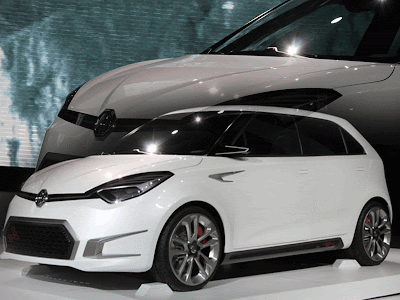At the Beijing Motor Show, Mercedes-Benz just unveiled a CLS Shooting Break concept that looks to us like a frontal attack on BMW’s 5-Series GT. The moniker, which is usually spelled “shooting brake”, does not refer to the braking system but originated with custom built two-door luxury estate cars altered for use by hunters and other sportsmen such as golfers, equestrians, and polo players requiring easy access to larger storage areas than offered by the typical automobile trunk. Of course, in true German fashion Mercedes insists its spelling is in fact the correct one.

Mercedes-Benz CLS Shooting Break concept
The original way of spelling it is break, and its origin comes from back to the horse-drawn carriage days, being the name given to carriages used to “break” in wild horses and also to restrict (or “brake”) their urge to move, so that they could be put to use as work horses.
There is no doubt one of the most iconic and important introductions of the last decade has been the Mercedes-Benz CLS “four-door coupe.”

Regardless of what you decide to call it, there's little doubt that this concept leaves the stuffy ‘old world’ shooting brake neatly in the dust, replacing it with what is essentially a sneak peek of what a wagon version of the next CLS sedan could look like.
Of course many of the oft-emulated CLS “four-door coupe” elements are there – the slippery arched profile; the swooping character line that runs seamlessly from front to rear; the long, taut body lines. But Mercedes has borrowed plenty of new elements to keep things fresh.

Those wide DTM-inspired rear fender haunches are pulled off the new E-Class sedan and coupe, and were also visible on the 2009 Concept FASCINATION that debuted in Paris. That concept also lends its wagon rear to the Shooting Brake – though curiously, no mention of that term was made two years ago. The nose incorporates the pronounced ‘classic style’ grille design of the new SLS AMG supercar, also seen in Mercedes’ F800 Style concept from the 2010 Geneva Motor Show – a car also said to give an advanced look at the next-generation CLS.

More elements from that concept also carry over, but in a more production-friendly way. The LED headlamps retain their sharp profile, but are made slightly larger; the aggressive lower front fascia is carried over nearly intact, with gaping air intakes flanking the center grille. Even the scalloped sides aft of the front wheel wells are present. Recessed door handles are said to emerge at the touch of a hand, yet sadly, the reverse-hinged rear passenger doors have been dropped from the package. Twenty-inch wheels fill out the Shooting Brake’s fender arches.

The Shooting Break concept car is driven by the forerunner to the forthcoming new V-engine generation from Mercedes-Benz. The special features of the spray-guided direct injection engine include the latest generation of piezo-electric injection valves which enable multiple injections.

Better lean operation is possible thanks to load monitoring of the pressure information. Even the operation of the ancillary components has been made efficient and there is also a start/stop function. The V6 with a 60 cylinder angle and displacement of 3.5 litres produces 225 kW (306 hp) with a maximum torque of 370 Nm.

Unlike the F800 Style concept, there is no fuel cell or hybrid technology lurking under the Shooting Brake concept’s hood. Instead, there sits what is said to be a forerunner to the next-generation of V-configuration Mercedes engines.

Featuring spray-guided direct-injection, piezo-electric injection valves, and start-stop technology, Mercedes says its next 60-degree-angle 3.5-liter V-6 will produce 306 horsepower with 273 pound-feet of torque.










